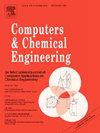A comparison of strategies to embed physics-informed neural networks in nonlinear model predictive control formulations solved via direct transcription
IF 3.9
2区 工程技术
Q2 COMPUTER SCIENCE, INTERDISCIPLINARY APPLICATIONS
引用次数: 0
Abstract
This study aims to benchmark candidate strategies for embedding neural network (NN) surrogates in nonlinear model predictive control (NMPC) formulations that are subject to systems described with partial differential equations and that are solved via direct transcription (i.e., simultaneous methods). This study focuses on the use of physics-informed NNs and physics-informed convolutional NNs as the internal (surrogate) models within the NMPC formulation. One strategy embeds NN models as explicit algebraic constraints, leveraging the automatic differentiation (AD) of an algebraic modelling language (AML) to evaluate the derivatives. Alternatively, the solver can be provided with derivatives computed external to the AML via the AD routines of the machine learning environment the NN is trained in. The three numerical experiments considered in this work reveal that replacing mechanistic models with NN surrogates may not always offer computational advantages when smooth activation functions are used in conjunction with a local nonlinear solver (e.g., Ipopt), even with highly nonlinear systems. Moreover, in this context, the external function evaluation of the NN surrogates often outperforms the embedding strategies that rely on explicit algebraic constraints, likely due to the difficulty in initializing the auxiliary variables and constraints introduced by explicit algebraic reformulations.
通过直接转录解决的非线性模型预测控制公式中嵌入物理信息神经网络的策略比较
本研究旨在对非线性模型预测控制(NMPC)公式中嵌入神经网络(NN)替代品的候选策略进行基准测试,这些策略受用偏微分方程描述的系统约束,并通过直接转录(即同时方法)求解。本研究的重点是使用物理信息神经网络和物理信息卷积神经网络作为NMPC公式中的内部(代理)模型。一种策略是将神经网络模型嵌入为显式代数约束,利用代数建模语言(AML)的自动微分(AD)来评估导数。或者,可以通过训练NN的机器学习环境的AD例程,为求解器提供AML外部计算的导数。在这项工作中考虑的三个数值实验表明,当光滑激活函数与局部非线性解算器(例如Ipopt)结合使用时,即使是高度非线性系统,用神经网络替代机制模型也不一定能提供计算优势。此外,在这种情况下,神经网络代理的外部函数评估通常优于依赖显式代数约束的嵌入策略,这可能是由于难以初始化显式代数重新表述引入的辅助变量和约束。
本文章由计算机程序翻译,如有差异,请以英文原文为准。
求助全文
约1分钟内获得全文
求助全文
来源期刊

Computers & Chemical Engineering
工程技术-工程:化工
CiteScore
8.70
自引率
14.00%
发文量
374
审稿时长
70 days
期刊介绍:
Computers & Chemical Engineering is primarily a journal of record for new developments in the application of computing and systems technology to chemical engineering problems.
 求助内容:
求助内容: 应助结果提醒方式:
应助结果提醒方式:


